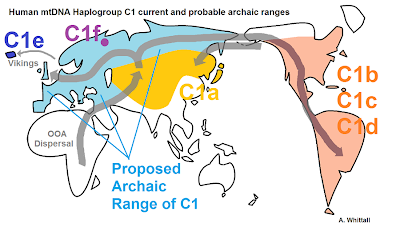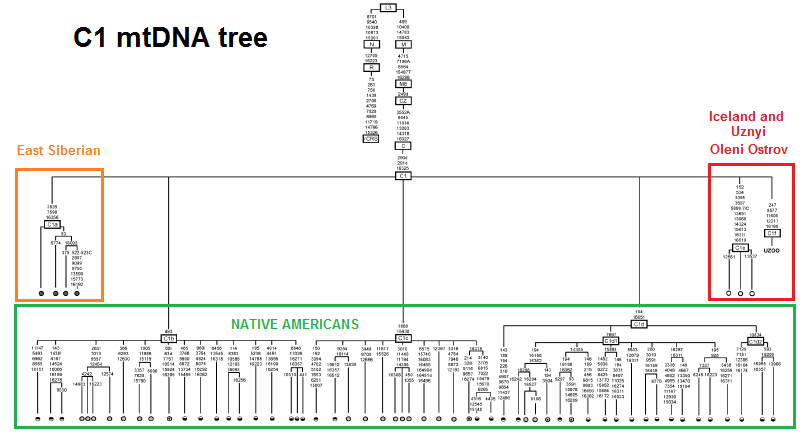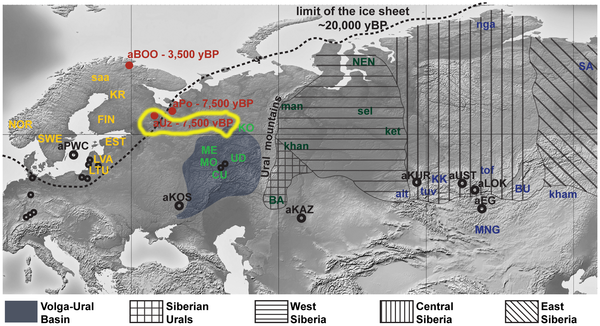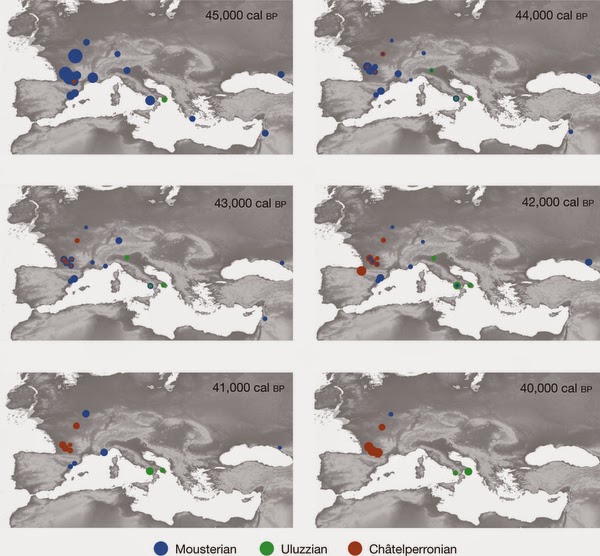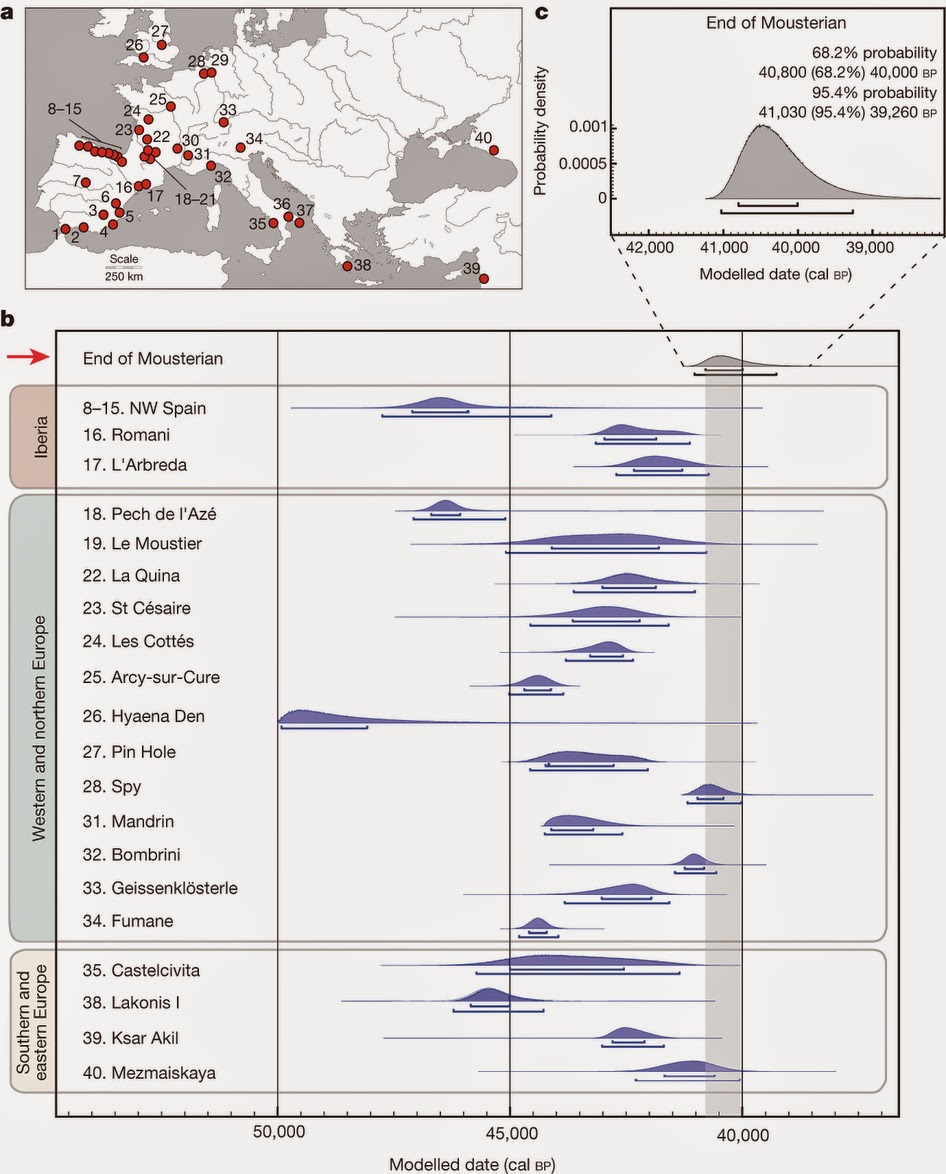Post by Admin on Dec 4, 2014 13:54:39 GMT
Virtual reconstruction (28) of the Mezmaiskaya specimen from 141 isolated but well preserved parts yielded an almost complete skull and a fairly complete postcranial skeleton (Fig. 1; SI Text, Virtual Reconstruction of the Mezmaiskaya Specimen and Figs. S1 and S2). Its morphology clearly indicates it is a Neanderthal, as does evidence from mtDNA analysis (24). Neanderthal apomorphies are a strongly projecting midface, a low position of the posterior semicircular canal of the inner ear relative to the lateral canal (high labyrinthine index), a low mandibular condyle, and a short tibial relative to femoral diaphyseal length (low crural index). Three-dimensional geometric morphometric analysis of the reconstructed cranial architecture also clearly groups the Mezmaiskaya individual with the Neanderthals (Fig. 2).

Fig. 1. Virtual reconstruction of the Mezmaiskaya Neanderthal. (A) Skeleton. (B) Skull in right lateral view. (Scale bars, 5 cm.)
Comparative analysis of linear craniodental and postcranial dimensions of the Mezmaiskaya specimen and of rAMHS perinatal samples (29) indicates that the Mezmaiskaya individual died between 1 and 2 weeks after birth (see SI Text, Comparative Morphometrics of the Mezmaiskaya Specimen, Table S2). The reconstructed endocranial volume (ECV) of the specimen is between 422 ccm and 436 ccm. Assuming similar perinatal endocranial growth rates for Neanderthals as for modern humans [20 ccm per week (30)], the Mezmaiskaya ECV at birth was 20 ccm to 40 ccm lower than at death. Subtraction of the latter range of estimates from the former yielded an ECV at birth between 382 ccm and 416 ccm, with a mean value at 399 ccm (SI Text, Comparative Morphometrics of the Mezmaiskaya Specimen). This figure corresponded to values obtained in vivo from modern human neonates [380–420 ccm (30)]. Our data thus confirm earlier hypotheses that the specific Neanderthal and AMHS morphologies developed during fetal life (31, 32) and suggest that the duration of Neanderthal pregnancy was similar as in rAMHS, assuming similar fetal growth rates.
Neonatal neurocranial size is a critical developmental and obstetric parameter in fossil and modern humans (33). To assess potential trade-offs between neonatal brain size and maternal pelvic dimensions in Neanderthals, we performed a virtual reconstruction of the fragmentary Tabun 1 female Neanderthal pelvis and simulated the Neanderthal birth process (Fig. 3; SI Text, Virtual Reconstruction of a Female Neanderthal Pelvis). Our data suggest that the Neanderthal female pelvic inlet was wider than in rAMHS, thus easily accommodating a full-term Neanderthal fetus. The reconstruction also indicates that female Neanderthal pelvic outlet dimensions might have been comparatively wide. However, due to the large neonate head, modern human-like rotational birth (in which the head of the neonate performs a quarter-turn from transverse to posteroanterior orientation during its passage through the birth canal) was the most probable option in Neanderthals. This would be in agreement with the hypothesis that rotational birth appeared during the Middle Pleistocene (34), probably in the last common ancestor of Neanderthals and AMHS.

Fig. 2. Geometric morphometric analysis of shape variability in a sample of immature Neanderthal and rAMHS crania. PC1 and PC2 are the first two shape components, which account for 27% and 13% of the total shape variability in the sample, respectively. PC1 captures shape change during cranial development in both Neanderthals and rAMHS, whereas PC2 captures major differences in cranial morphology between Neanderthals and AMHS. Filled symbols: Neanderthal specimens [M, Mezmaiskaya (four reconstructive variants enclosed in 95% density ellipse); P, Pech de l'Azé; D1 and D2, Dederiyeh 1 and 2; S, Subalyuk 2; E, Engis 2; R, Roc de Marsal; G, Gibraltar 2]. Open symbols: rAMHS (mixed European/African/Asian sample). Diamonds: fetuses; circles: neonates; triangles: 0.5 to <3 years; squares: 3 years to ≤5.5 years.
To test whether early postnatal brain development was more rapid in Neanderthals than in rAMHS, we performed virtual cranial reconstructions of the Dederiyeh specimens (SI Text, Virtual Reconstruction of the Dederiyeh 1 and 2 Neanderthal Infant Specimens and Fig. S3). ECVs of Dederiyeh 1 and 2 are 1,096 ccm and 1,089 ccm, respectively. ECVs of the slightly older specimens from Pech de l'Azé (estimated individual age: 2.2 y) and Subalyuk 2 (3.2 y) (31) are 1,135 ccm and 1,187 ccm, respectively. Together, these data indicate that ECVs of very young Neanderthals are at the upper end of variation of rAMHS ECVs (2) at corresponding ages. Comparison of endocranial growth trajectories from birth to adulthood further indicates that on average, Neanderthal brains expanded at a higher rate and attained larger adult volumes than those of rAMHS (Fig. 4A). However, Neanderthal and rAMHS trajectories coincide when related to taxon-specific adult mean ECVs (Fig. 4B), indicating that both taxa reached adult sizes within the same time period, and along equivalent trajectories. Together, these graphs show that compared with rAMHS, Neanderthals attained their larger adult brains via higher growth rates rather than via an extended growth period. The graphs also show that higher growth rates do not imply faster completion of brain growth.

Fig. 3. Reconstruction of Neanderthal birth (crossed stereo pictures). The pelvic reconstruction combines elements of the Tabun 1 specimen (ilium, ischium, pubis) with their mirror-imaged counterparts (transparent), and replacement parts (violet) from a modern human female pelvis (sacrum, ischial spines). The Mezmaiskaya skull is visualized during its passage through the pelvic inlet. (Scale bar, 10 cm.) (See also SI Text, Virtual Reconstruction of a Female Neanderthal Pelvis and Figs. S4 and S5).
To test whether early postnatal brain development was more rapid in Neanderthals than in rAMHS, we performed virtual cranial reconstructions of the Dederiyeh specimens (SI Text, Virtual Reconstruction of the Dederiyeh 1 and 2 Neanderthal Infant Specimens and Fig. S3). ECVs of Dederiyeh 1 and 2 are 1,096 ccm and 1,089 ccm, respectively. ECVs of the slightly older specimens from Pech de l'Azé (estimated individual age: 2.2 y) and Subalyuk 2 (3.2 y) (31) are 1,135 ccm and 1,187 ccm, respectively. Together, these data indicate that ECVs of very young Neanderthals are at the upper end of variation of rAMHS ECVs (2) at corresponding ages. Comparison of endocranial growth trajectories from birth to adulthood further indicates that on average, Neanderthal brains expanded at a higher rate and attained larger adult volumes than those of rAMHS (Fig. 4A). However, Neanderthal and rAMHS trajectories coincide when related to taxon-specific adult mean ECVs (Fig. 4B), indicating that both taxa reached adult sizes within the same time period, and along equivalent trajectories. Together, these graphs show that compared with rAMHS, Neanderthals attained their larger adult brains via higher growth rates rather than via an extended growth period. The graphs also show that higher growth rates do not imply faster completion of brain growth.

Fig. 4. Postnatal endocranial volume (ECV) growth in Neanderthals, rAMHS, and chimpanzees. (A) Growth as a percentage of neonate taxon-specific mean ECV values (Neanderthals: 400 ccm, rAMHS: 400 ccm, chimpanzees: 155 ccm). (B) Growth as a percentage of adult taxon-specific mean ECV values (1,500 ccm, 1,350 ccm, 386 ccm). Solid lines: rAMHS mean ± SD; dashed lines: chimpanzee mean ± SD (data from refs. 2, 48, and 49). Circles: Neanderthal individuals (from left to right and bottom to top: Mezmaiskaya, Dederiyeh 1 and 2, Pech de l'Azé, Subalyuk 2, Roc de Marsal, Gibraltar 2, Engis 2, La Quina 18, Teshik Tash, Le Moustier 1, Tabun 1, Gibraltar 1, La Ferrassie 1, Amud 1); horizontal bars: estimated range of individual age. In A, note that Neanderthals are at the upper range of the rAMHS distribution. In B, note complete overlap between Neanderthal and rAMHS trajectories, and overlap between chimpanzee and hominin trajectories after an age of 2 years.
These findings permit several inferences regarding the evolution of brain growth patterns and of human life history. A neonate brain size of ≈400 ccm is most likely a feature of the last common ancestor of Neanderthals and AMHS, and it might represent the upper physiological and obstetrical limit that can be attained in hominins, irrespective of the course of postnatal brain expansion. Various studies have proposed that a large neonatal brain size (≈300 ccm) and secondary altriciality were features already present in H. erectus (4, 9, 35) (estimates are summarized in SI Text, Estimates of Homo erectus Neonatal Brain Size). Because fetal brain growth requires substantial maternal energy investment (36), a large neonatal brain size must have represented a significant selective advantage in H. erectus, possibly by providing the primary substrate for complex learning tasks during childhood (4). Likewise, the high early postnatal brain growth rates of Neanderthals and AMHS compared with chimpanzees, which imply a more than twofold increase of ECV during the 1st year of life, might be a feature of their last common ancestor, and there is evidence that high postnatal brain growth rates might already have evolved in H. erectus (4, 9). Overall, therefore, our data support the hypothesis (4, 9) that the origins of “modern” human-like patterns of brain growth and life history must be sought relatively early during the evolution of the genus Homo.
High postnatal brain growth rates have been interpreted as an evolutionary extension of fetal modes of growth into early infancy (36), and this is thought to be the main ontogenetic mechanism to attain an exceptionally high degree of encephalization during adulthood (2). What are the implications of this pattern of brain growth for life history evolution? Recent analyses suggest that the correlation between brain growth patterns, adult brain size, and life history is indirect and results from maternal energetic constraints (2, 5, 7): The additional energetic costs of the fast-growing infant brain are mainly sustained by the mother, such that species investing in large infant brains that grow at high rates to reach large adult sizes require large, late-maturing mothers (2, 5).
In this context, the higher early brain growth rates and larger adult brains of the Neanderthals compared with rAMHS have interesting implications. The pattern of Neanderthal brain growth fits into the general pattern of rate hypermorphosis in this species: Compared with rAMHS, Neanderthals have been shown to attain larger adult cranial sizes and more advanced (peramorphic) shapes within a given period of ontogenetic time (31). Rate hypermorphosis might be a correlate of greater average body size in Neanderthals compared with rAMHS (21, 22). However, it does not imply earlier cessation of brain growth (Fig. 4B), nor does it imply a faster pace of life history (as was suggested in refs. 18 and 19): In light of the maternal energetic constraints hypothesis (2, 5), our results suggest that Neanderthal life history had a similarly slow pace as that of rAMHS, and probably was even somewhat slower.
What are the potential developmental, cognitive, and phyletic implications of these subtle developmental differences between the brains of Neanderthals and rAMHS? In recent humans, the temporal course of endocranial volume expansion is only loosely correlated with the temporal course of brain maturation (37), such that hypotheses regarding differences in cognitive development cannot be substantiated with fossil evidence. Nevertheless, several hypotheses can be proposed to explain how differences in brain growth rates between Neanderthals and AMHS evolved. High brain growth rates in the Neanderthals could represent a derived feature. This hypothesis would be in concert with the notion that Neanderthal morphology is derived in many respects. As an alternative hypothesis, high rates in the Neanderthals might represent an ancestral condition, probably shared with eAMHS as opposed to rAMHS, whose lower brain growth rates would represent a derived condition. Support for this hypothesis comes from the observation that adult brain size of eAMHS was similar in range to that of the Neanderthals (38, 39), such that it is likely that brain growth rates were similar as well.
According to this second hypothesis, the high ancestral rates of brain growth were probably reduced only relatively recently during AMHS evolution. Brain size reduction in AMHS during the late Pleistocene is well documented, and it went in parallel with body size reduction (39). We can only speculate on potential selective constraints driving this evolutionary trend toward rate hypomorphosis. Evidence from recent human populations indicates that size reduction is correlated with faster life histories and higher mortality risks (40). Alternatively, brain size reduction during the Late Pleistocene could be the result of an evolutionary performance optimization. Evidence for substantial cerebral reorganization comes from Late Pleistocene AMHS (Cro-Magnon 1) and Neanderthals (La Chapelle-aux-Saints 1, La Ferrassie 1, and Forbes' Quarry 1), which had larger cerebral hemispheres relative to cerebellum volume than modern humans (41). It could be argued that growing smaller—but similarly efficient—brains required less energy investment and might ultimately have led to higher net reproduction rates. Such an evolutionary shift might have contributed to the rapid expansion of Upper Paleolithic AMHS populations into Eurasia.
The notion that genes down-regulating rates of early brain growth might have contributed to the fitness of our own species is an intriguing, but testable, hypothesis. Genes involved in the regulation of brain growth that show evidence of recent selective sweeps are of special interest (42, 43), but their known normal variants do not account for variation in brain size (44). Further research is thus necessary to clarify the genetic basis of brain and body size variation in modern humans and its relationship to life history variation. Overall, integrating neurocranial, dentognathic, and postcranial data on Neanderthal and AMHS development reveals a complex pattern of between-taxon and within-taxon variability of life history-related variables, and indicates that hominin life history evolution was a modular (5), mosaic-like, rather than a linear, process. Inferences on the evolution of hominin life history and cognitive development must be drawn with caution, especially when drawn from isolated aspects of fossil morphology.
de León, Marcia S. Ponce, et al. "Neanderthal brain size at birth provides insights into the evolution of human life." History Proceedings of the National Academy of Sciences 105.37 (2008): 13764-13768. www.pnas.org/content/105/37/13764.long

Fig. 1. Virtual reconstruction of the Mezmaiskaya Neanderthal. (A) Skeleton. (B) Skull in right lateral view. (Scale bars, 5 cm.)
Comparative analysis of linear craniodental and postcranial dimensions of the Mezmaiskaya specimen and of rAMHS perinatal samples (29) indicates that the Mezmaiskaya individual died between 1 and 2 weeks after birth (see SI Text, Comparative Morphometrics of the Mezmaiskaya Specimen, Table S2). The reconstructed endocranial volume (ECV) of the specimen is between 422 ccm and 436 ccm. Assuming similar perinatal endocranial growth rates for Neanderthals as for modern humans [20 ccm per week (30)], the Mezmaiskaya ECV at birth was 20 ccm to 40 ccm lower than at death. Subtraction of the latter range of estimates from the former yielded an ECV at birth between 382 ccm and 416 ccm, with a mean value at 399 ccm (SI Text, Comparative Morphometrics of the Mezmaiskaya Specimen). This figure corresponded to values obtained in vivo from modern human neonates [380–420 ccm (30)]. Our data thus confirm earlier hypotheses that the specific Neanderthal and AMHS morphologies developed during fetal life (31, 32) and suggest that the duration of Neanderthal pregnancy was similar as in rAMHS, assuming similar fetal growth rates.
Neonatal neurocranial size is a critical developmental and obstetric parameter in fossil and modern humans (33). To assess potential trade-offs between neonatal brain size and maternal pelvic dimensions in Neanderthals, we performed a virtual reconstruction of the fragmentary Tabun 1 female Neanderthal pelvis and simulated the Neanderthal birth process (Fig. 3; SI Text, Virtual Reconstruction of a Female Neanderthal Pelvis). Our data suggest that the Neanderthal female pelvic inlet was wider than in rAMHS, thus easily accommodating a full-term Neanderthal fetus. The reconstruction also indicates that female Neanderthal pelvic outlet dimensions might have been comparatively wide. However, due to the large neonate head, modern human-like rotational birth (in which the head of the neonate performs a quarter-turn from transverse to posteroanterior orientation during its passage through the birth canal) was the most probable option in Neanderthals. This would be in agreement with the hypothesis that rotational birth appeared during the Middle Pleistocene (34), probably in the last common ancestor of Neanderthals and AMHS.

Fig. 2. Geometric morphometric analysis of shape variability in a sample of immature Neanderthal and rAMHS crania. PC1 and PC2 are the first two shape components, which account for 27% and 13% of the total shape variability in the sample, respectively. PC1 captures shape change during cranial development in both Neanderthals and rAMHS, whereas PC2 captures major differences in cranial morphology between Neanderthals and AMHS. Filled symbols: Neanderthal specimens [M, Mezmaiskaya (four reconstructive variants enclosed in 95% density ellipse); P, Pech de l'Azé; D1 and D2, Dederiyeh 1 and 2; S, Subalyuk 2; E, Engis 2; R, Roc de Marsal; G, Gibraltar 2]. Open symbols: rAMHS (mixed European/African/Asian sample). Diamonds: fetuses; circles: neonates; triangles: 0.5 to <3 years; squares: 3 years to ≤5.5 years.
To test whether early postnatal brain development was more rapid in Neanderthals than in rAMHS, we performed virtual cranial reconstructions of the Dederiyeh specimens (SI Text, Virtual Reconstruction of the Dederiyeh 1 and 2 Neanderthal Infant Specimens and Fig. S3). ECVs of Dederiyeh 1 and 2 are 1,096 ccm and 1,089 ccm, respectively. ECVs of the slightly older specimens from Pech de l'Azé (estimated individual age: 2.2 y) and Subalyuk 2 (3.2 y) (31) are 1,135 ccm and 1,187 ccm, respectively. Together, these data indicate that ECVs of very young Neanderthals are at the upper end of variation of rAMHS ECVs (2) at corresponding ages. Comparison of endocranial growth trajectories from birth to adulthood further indicates that on average, Neanderthal brains expanded at a higher rate and attained larger adult volumes than those of rAMHS (Fig. 4A). However, Neanderthal and rAMHS trajectories coincide when related to taxon-specific adult mean ECVs (Fig. 4B), indicating that both taxa reached adult sizes within the same time period, and along equivalent trajectories. Together, these graphs show that compared with rAMHS, Neanderthals attained their larger adult brains via higher growth rates rather than via an extended growth period. The graphs also show that higher growth rates do not imply faster completion of brain growth.

Fig. 3. Reconstruction of Neanderthal birth (crossed stereo pictures). The pelvic reconstruction combines elements of the Tabun 1 specimen (ilium, ischium, pubis) with their mirror-imaged counterparts (transparent), and replacement parts (violet) from a modern human female pelvis (sacrum, ischial spines). The Mezmaiskaya skull is visualized during its passage through the pelvic inlet. (Scale bar, 10 cm.) (See also SI Text, Virtual Reconstruction of a Female Neanderthal Pelvis and Figs. S4 and S5).
To test whether early postnatal brain development was more rapid in Neanderthals than in rAMHS, we performed virtual cranial reconstructions of the Dederiyeh specimens (SI Text, Virtual Reconstruction of the Dederiyeh 1 and 2 Neanderthal Infant Specimens and Fig. S3). ECVs of Dederiyeh 1 and 2 are 1,096 ccm and 1,089 ccm, respectively. ECVs of the slightly older specimens from Pech de l'Azé (estimated individual age: 2.2 y) and Subalyuk 2 (3.2 y) (31) are 1,135 ccm and 1,187 ccm, respectively. Together, these data indicate that ECVs of very young Neanderthals are at the upper end of variation of rAMHS ECVs (2) at corresponding ages. Comparison of endocranial growth trajectories from birth to adulthood further indicates that on average, Neanderthal brains expanded at a higher rate and attained larger adult volumes than those of rAMHS (Fig. 4A). However, Neanderthal and rAMHS trajectories coincide when related to taxon-specific adult mean ECVs (Fig. 4B), indicating that both taxa reached adult sizes within the same time period, and along equivalent trajectories. Together, these graphs show that compared with rAMHS, Neanderthals attained their larger adult brains via higher growth rates rather than via an extended growth period. The graphs also show that higher growth rates do not imply faster completion of brain growth.

Fig. 4. Postnatal endocranial volume (ECV) growth in Neanderthals, rAMHS, and chimpanzees. (A) Growth as a percentage of neonate taxon-specific mean ECV values (Neanderthals: 400 ccm, rAMHS: 400 ccm, chimpanzees: 155 ccm). (B) Growth as a percentage of adult taxon-specific mean ECV values (1,500 ccm, 1,350 ccm, 386 ccm). Solid lines: rAMHS mean ± SD; dashed lines: chimpanzee mean ± SD (data from refs. 2, 48, and 49). Circles: Neanderthal individuals (from left to right and bottom to top: Mezmaiskaya, Dederiyeh 1 and 2, Pech de l'Azé, Subalyuk 2, Roc de Marsal, Gibraltar 2, Engis 2, La Quina 18, Teshik Tash, Le Moustier 1, Tabun 1, Gibraltar 1, La Ferrassie 1, Amud 1); horizontal bars: estimated range of individual age. In A, note that Neanderthals are at the upper range of the rAMHS distribution. In B, note complete overlap between Neanderthal and rAMHS trajectories, and overlap between chimpanzee and hominin trajectories after an age of 2 years.
These findings permit several inferences regarding the evolution of brain growth patterns and of human life history. A neonate brain size of ≈400 ccm is most likely a feature of the last common ancestor of Neanderthals and AMHS, and it might represent the upper physiological and obstetrical limit that can be attained in hominins, irrespective of the course of postnatal brain expansion. Various studies have proposed that a large neonatal brain size (≈300 ccm) and secondary altriciality were features already present in H. erectus (4, 9, 35) (estimates are summarized in SI Text, Estimates of Homo erectus Neonatal Brain Size). Because fetal brain growth requires substantial maternal energy investment (36), a large neonatal brain size must have represented a significant selective advantage in H. erectus, possibly by providing the primary substrate for complex learning tasks during childhood (4). Likewise, the high early postnatal brain growth rates of Neanderthals and AMHS compared with chimpanzees, which imply a more than twofold increase of ECV during the 1st year of life, might be a feature of their last common ancestor, and there is evidence that high postnatal brain growth rates might already have evolved in H. erectus (4, 9). Overall, therefore, our data support the hypothesis (4, 9) that the origins of “modern” human-like patterns of brain growth and life history must be sought relatively early during the evolution of the genus Homo.
High postnatal brain growth rates have been interpreted as an evolutionary extension of fetal modes of growth into early infancy (36), and this is thought to be the main ontogenetic mechanism to attain an exceptionally high degree of encephalization during adulthood (2). What are the implications of this pattern of brain growth for life history evolution? Recent analyses suggest that the correlation between brain growth patterns, adult brain size, and life history is indirect and results from maternal energetic constraints (2, 5, 7): The additional energetic costs of the fast-growing infant brain are mainly sustained by the mother, such that species investing in large infant brains that grow at high rates to reach large adult sizes require large, late-maturing mothers (2, 5).
In this context, the higher early brain growth rates and larger adult brains of the Neanderthals compared with rAMHS have interesting implications. The pattern of Neanderthal brain growth fits into the general pattern of rate hypermorphosis in this species: Compared with rAMHS, Neanderthals have been shown to attain larger adult cranial sizes and more advanced (peramorphic) shapes within a given period of ontogenetic time (31). Rate hypermorphosis might be a correlate of greater average body size in Neanderthals compared with rAMHS (21, 22). However, it does not imply earlier cessation of brain growth (Fig. 4B), nor does it imply a faster pace of life history (as was suggested in refs. 18 and 19): In light of the maternal energetic constraints hypothesis (2, 5), our results suggest that Neanderthal life history had a similarly slow pace as that of rAMHS, and probably was even somewhat slower.
What are the potential developmental, cognitive, and phyletic implications of these subtle developmental differences between the brains of Neanderthals and rAMHS? In recent humans, the temporal course of endocranial volume expansion is only loosely correlated with the temporal course of brain maturation (37), such that hypotheses regarding differences in cognitive development cannot be substantiated with fossil evidence. Nevertheless, several hypotheses can be proposed to explain how differences in brain growth rates between Neanderthals and AMHS evolved. High brain growth rates in the Neanderthals could represent a derived feature. This hypothesis would be in concert with the notion that Neanderthal morphology is derived in many respects. As an alternative hypothesis, high rates in the Neanderthals might represent an ancestral condition, probably shared with eAMHS as opposed to rAMHS, whose lower brain growth rates would represent a derived condition. Support for this hypothesis comes from the observation that adult brain size of eAMHS was similar in range to that of the Neanderthals (38, 39), such that it is likely that brain growth rates were similar as well.
According to this second hypothesis, the high ancestral rates of brain growth were probably reduced only relatively recently during AMHS evolution. Brain size reduction in AMHS during the late Pleistocene is well documented, and it went in parallel with body size reduction (39). We can only speculate on potential selective constraints driving this evolutionary trend toward rate hypomorphosis. Evidence from recent human populations indicates that size reduction is correlated with faster life histories and higher mortality risks (40). Alternatively, brain size reduction during the Late Pleistocene could be the result of an evolutionary performance optimization. Evidence for substantial cerebral reorganization comes from Late Pleistocene AMHS (Cro-Magnon 1) and Neanderthals (La Chapelle-aux-Saints 1, La Ferrassie 1, and Forbes' Quarry 1), which had larger cerebral hemispheres relative to cerebellum volume than modern humans (41). It could be argued that growing smaller—but similarly efficient—brains required less energy investment and might ultimately have led to higher net reproduction rates. Such an evolutionary shift might have contributed to the rapid expansion of Upper Paleolithic AMHS populations into Eurasia.
The notion that genes down-regulating rates of early brain growth might have contributed to the fitness of our own species is an intriguing, but testable, hypothesis. Genes involved in the regulation of brain growth that show evidence of recent selective sweeps are of special interest (42, 43), but their known normal variants do not account for variation in brain size (44). Further research is thus necessary to clarify the genetic basis of brain and body size variation in modern humans and its relationship to life history variation. Overall, integrating neurocranial, dentognathic, and postcranial data on Neanderthal and AMHS development reveals a complex pattern of between-taxon and within-taxon variability of life history-related variables, and indicates that hominin life history evolution was a modular (5), mosaic-like, rather than a linear, process. Inferences on the evolution of hominin life history and cognitive development must be drawn with caution, especially when drawn from isolated aspects of fossil morphology.
de León, Marcia S. Ponce, et al. "Neanderthal brain size at birth provides insights into the evolution of human life." History Proceedings of the National Academy of Sciences 105.37 (2008): 13764-13768. www.pnas.org/content/105/37/13764.long

